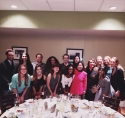The Women’s and Gender Studies Program began in the Spring of 1987, when a minor in Women’s Studies was formally launched as an interdisciplinary program within the College. In celebration of this 30-year milestone, the University Archives takes a look back at the evolution of the program, from its beginnings as a minor program to its growth into a major program in Women’s and Gender Studies.
The Women’s and Gender Studies Program culminates a year of their own celebratory events and activities on March 15, 2018, by hosting the academic conference “Feminist Futures: Our Struggles for the Next 30 Years.”
Women Academics at Georgetown Brown Bag Lunch announcement, 1982
The Women’s and Gender Studies Program can trace its roots back to the early 1970s and 1980s. During that time, several informal groups of women on campus began to meet to discuss topics of interest to women in general as well as to discuss their common concerns as women at Georgetown. The topics were wide-ranging, from issues related to promotion and tenure and securing grant funding for research, to health services and day care needs. One of these groups, the Women Academics at Georgetown, held a regular speaker series on such topics, as depicted in this announcement from 1982. The Women’s Studies Committee, the group that would draft the proposal for the minor in Women’s Studies, grew out of the Women Academics at Georgetown.
“College Opens Women’s Studies Minor,” The Hoya, April 10, 1987
In the Fall of 1982, College Dean Royden Davis, S.J., established a Women’s Studies Committee to explore the creation of a women’s studies program at Georgetown. The group drew up a proposal for an interdisciplinary minor, asserting that the creation of a Women’s Studies program would help to satisfy several objectives of the University’s 5-year plan at the time: to strengthen interdisciplinary programs, develop wider interdisciplinary opportunities, work to strengthen the sense of community among the faculty, and to meet affirmative action guidelines. Approval of the minor wouldn’t come for several more years.
During the intervening years, the College began offering an introductory course on women’s studies in the Spring of 1983 as a way to test interest in the subject. By the Fall of 1984, this introductory course was offered every semester, and the class was so popular that it regularly had a wait list. In 1986, the College Executive Committee approved the creation of a minor in Women’s Studies to begin in the Spring of 1987.
List of Women’s Studies course offerings for the Spring 1987 semester, Georgetown Undergraduate Bulletin, 1987–88
Leona Fisher, Ye Domesday Booke 1982
Now Professor Emerita in the Department of English, Fisher served as the first chair of the Women’s Studies Program, 1987–1993.
Along with Fisher, many other Georgetown women faculty and administrators worked tirelessly to bring about the Women’s Studies Program as well as other important resources for women and women’s issues on campus, such as the Women’s Center. These included Anne Sullivan, Senior Associate Dean in the College; Sue Lanser, Caren Kaplan, and Margaret Stetz in the English Department; Margaret Hall in the Sociology Department; Jouette Bassler and Grace Burford in the Theology Department; JoAnn Moran in the History Department; Suzanne Pallack in the Psychology Department; and Madonna Kolbenschlag in the Woodstock Center, among others.
“Poised for Growth: The Challenge of Proposing a Women’s Studies Major,” The New Press, Spring 1992
The first five years of the Women’s Studies minor proved successful, but a lack of resources and staff were hampering the growth of the program. In 1992, the Women’s Studies Advisory Board met to draft a proposal to establish a Women’s Studies major program with more funding to expand the course load and hire more faculty. Realization of that goal would come two years later in 1994, when Women’s Studies was expanded into a major within the College’s Interdisciplinary Studies Program. In 2000, a certificate in Women’s Studies was a choice offered to students in the Foreign Service School.
In the Fall of 2017, a student-led proposal was submitted to the Dean of Georgetown College to have the Women’s and Gender Studies Program gain full department status by the Fall of 2018. The proposal notes that the lack of department status poses financial and professional advancement challenges for the Program’s faculty.
Event flyer for lecture by Naomi Wolfe, November 3, 1993
In addition to the curricular component of the program, Women’s Studies also sponsored a variety of events on and off campus, from academic lectures and panel discussions to performing arts and social events, often partnering with a diverse range of programs, centers, schools, and groups across campus.
Event flyer for “Africana Woman: Her Story Through Time,” March 2004
Undergraduate Bulletin depicting the program name change to Women’s and Gender Studies, 2006–2007
In 2006, the Women’s Studies Program was elevated to a free-standing major program within Interdisciplinary Studies. The program also took on a new name, Women’s and Gender Studies, to reflect the way that the field had come to encompass gender as a larger field of study.
Women’s Studies Program Seniors’ Dinner Event Program, April 24, 2007
This annual event includes presentations by the seniors in the program and announcement of the Outstanding Senior Award.
Photograph from the Women’s and Gender Studies Senior Dinner, 2017
Pictured with the seniors is Director of the Women’s and Gender Studies Program, You-Me Park.
Curated by Collections, Research and Instruction Librarians Maura Seale, Jill Hollingsworth, and Megan Browndorf and Assistant University Archivist Ann Galloway.


